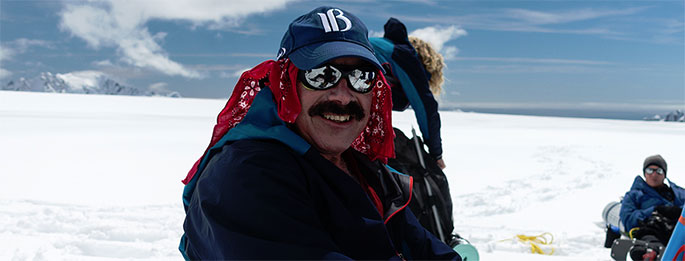Geneticist Pushes Limits in Lab and in Life
Vitiligo expert Richard Spritz races cars, hikes Himalayas while doing groundbreaking research

Michael Davidson
(May 2017) Richard Spritz, MD, likes to be on the edge. Spritz, director of the Human Medical Genetics and Genomics Program, loves the rush of pushing his vintage Porsche 911 around a racetrack. He hikes in the Himalayas, and spent his most recent vacation trekking across a remote island, following the footsteps of famous Antarctic explorer Ernest Shackleton.
A career spent in a laboratory might seem less exciting, but not for Spritz. While he once was an accomplished mountain climber and survived two avalanches while backcountry skiing, he says his passion is not for taking risks—it is for the thrill of doing something new.
“I think that science is an incredibly adventurous thing. You’re always pushing beyond what’s known,” Spritz said. “I’m not an adrenaline junkie. Other people might call me that. I’ve just always been attracted to adventurous things.”
In Spritz’s eyes, there have been
Fateful decisions
Spritz, 66, is one of the world’s leading vitiligo researchers. For almost two decades, he’s been conducting groundbreaking work understanding the genetics behind the skin pigmentation disorder that causes white patches to appear on the face, body
Spritz is from Philadelphia, but feeling the mountains’ call, he became an accomplished mountain climber in his youth. Successful ascents in the Alps, including the notoriously dangerous north face of the Eiger, earned him the respect of the climbing elite, and in the 1970s an invitation to climb Mount Everest.
Spritz declined because he was in medical school and did not want to disrupt his career. “I absolutely made the right choice,” he said.
“It’s mostly out of my system,” Spritz said. But he’s not through going on adventures, and last fall he hiked across South Georgia, an island near Antarctica. Peter Hillary and Jamling
Spritz made a career-defining decision “literally one day while walking down the street,” he said. He had planned to become a
“I was incredibly lucky, because I did that at exactly the right moment in history, at the beginning of recombinant DNA research,” Spritz said. “I was lucky to get in on the ground floor.”
In the late 1970s, researchers were just discovering how to isolate, identify and sequence human genes. The biggest early discovery Spritz was part of was finding and sequencing a mutation that affects hemoglobin, the molecule that carries oxygen in the blood. It was the first time a mutation had been sequenced.
Still making discoveries
In October, Spritz and his lab published a paper in Nature Genetics finding 23 genes linked to susceptibility for vitiligo. The lab tested 4,680 people with the condition and 39,586 control cases. The study attracted the attention of pharmaceutical companies, which Spritz said is good news because
“Despite the fact that vitiligo has been known for hundreds of years, there’s never been a drug developed for it,” Spritz said. “That might change in the near future.”
People with other conditions might benefit as well. In the mid-2000s, Spritz established that vitiligo was an autoimmune disease, in which the body attacks its own skin pigmentation cells. Research has shown people susceptible to vitiligo have increased odds of other autoimmune conditions such as Type I diabetes, rheumatoid arthritis
That would be the next chapter in an ongoing scientific adventure. “It’s amazing to me how far we’ve come, how naïve we were and yet how prescient we were at the same time,” Spritz said. “We are asking and answering the kinds of questions we couldn’t have imagined when I was a student. I think that’s incredibly inspirational – and we’ve hardly started.”